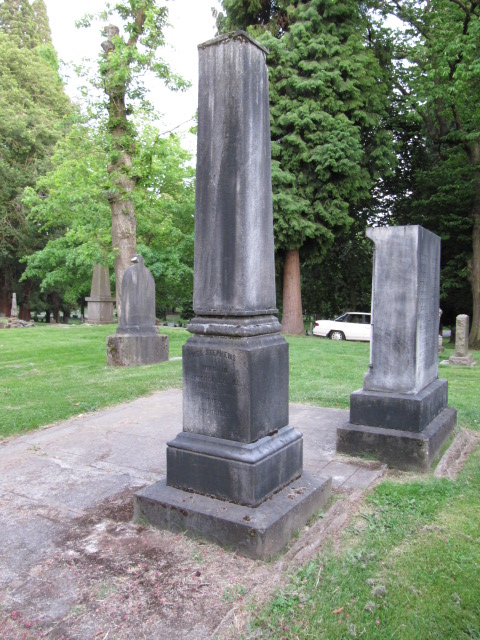Emmor Stephens, the son of Thomas and Jane (Jefferson) Stephens, was reared on his father's plantations in Maryland and Virginia. Later, he traveled with his younger brother, Isaac Stephens, to western Virginia and worked as a barge tender along the busy Ohio River.
In 1800, at 23, Emmor married Elizabeth (nee Boals/Bowles) Hannal, a widow. Virtually nothing is known about her first husband. Elizabeth's sister, Mary Boals/Bowles, became the wife of Emmor's brother, Isaac N. Stephens. The sisters are traditionally believed to have been descendants of the large Boal family of Lancaster and Dauphin Counties, Pennsylvania. The family name is spelled, variously, as Boal, Boals, or Bowles. According to some historians, the Boal clan's ancestors were Ulstermen from County Derry, Ireland, while others claim the family's antecedents were Dutchmen. In any case, Elizabeth and Mary's immediate forebears probably lived either in Washington County, Pennsylvania, or in what is now Brooke County, West Virginia. Their mother is believed to have been born with the maiden surname of Fulton, a theory that is supported by one family chronicle claiming that Robert Fulton (1765-1815), the Lancaster County native who achieved international fame as the inventor of the steamboat, was a first cousin to Elizabeth and Mary Boals. They likely had siblings, but only one other sister is known from existing records.
With their rapidly increasing brood of children, Emmor and Elizabeth Stephens lived in several Ohio River Valley locations, including the obscure Virginia settlement of Maggin's Ferry, and the then-isolated Western Reserve community of Louder, in Indiana Territory. In 1814 the couple traveled by keel boat to Jefferson County, Indiana, and took up residence in Republican Township west of the village of Madison, where they farmed. Eight years later, Elizabeth died on the home place following the birth of her eleventh child.
Later, Emmor reared six more children with his youthful and diminutive second wife, Jemima Heppas, a widow from Kentucky. The family lived for several years in Jefferson and Harrison Counties, Indiana, but by 1843 had settled on a farm formerly belonging to Emmor's second-eldest son, James B. Stephens, near Carthage, Hancock County, Illinois.
In 1844 Emmor and Jemima made the fateful decision to settle in the Oregon Country. The following spring the couple sold their Illinois property and traveled to Missouri where they signed with a well-provisioned company of 150 wagons that departed Saint Joseph on April 15, 1845. The Stephens group included not only Emmor and Jemima and their six children, but several of Emmor's children and grandchildren from his first marriage as well. After the caravan reached the Platte River in Nebraska, tragedy struck when Jemima Stephens fell victim to "dropsy," a form of heart disease. Her grave, located in a now-forgotten wayside along the route, was concealed in a cactus bed to prevent the Indians from desecrating the remains.
His helpmate's untimely death and the difficult ordeal of the overland trek to the Oregon Country were double blows from which Emmor Stephens never recovered. Less than six months after his arrival in Oregon's Willamette Valley, the 68-year-old pioneer succumbed to a lingering illness and was buried in a berry patch on the Donation Land Claim of his son, James B. Stephens. Emmor's grave was the first in what later became Portland's historic Lone Fir Cemetery.
Emmor Stephens, the son of Thomas and Jane (Jefferson) Stephens, was reared on his father's plantations in Maryland and Virginia. Later, he traveled with his younger brother, Isaac Stephens, to western Virginia and worked as a barge tender along the busy Ohio River.
In 1800, at 23, Emmor married Elizabeth (nee Boals/Bowles) Hannal, a widow. Virtually nothing is known about her first husband. Elizabeth's sister, Mary Boals/Bowles, became the wife of Emmor's brother, Isaac N. Stephens. The sisters are traditionally believed to have been descendants of the large Boal family of Lancaster and Dauphin Counties, Pennsylvania. The family name is spelled, variously, as Boal, Boals, or Bowles. According to some historians, the Boal clan's ancestors were Ulstermen from County Derry, Ireland, while others claim the family's antecedents were Dutchmen. In any case, Elizabeth and Mary's immediate forebears probably lived either in Washington County, Pennsylvania, or in what is now Brooke County, West Virginia. Their mother is believed to have been born with the maiden surname of Fulton, a theory that is supported by one family chronicle claiming that Robert Fulton (1765-1815), the Lancaster County native who achieved international fame as the inventor of the steamboat, was a first cousin to Elizabeth and Mary Boals. They likely had siblings, but only one other sister is known from existing records.
With their rapidly increasing brood of children, Emmor and Elizabeth Stephens lived in several Ohio River Valley locations, including the obscure Virginia settlement of Maggin's Ferry, and the then-isolated Western Reserve community of Louder, in Indiana Territory. In 1814 the couple traveled by keel boat to Jefferson County, Indiana, and took up residence in Republican Township west of the village of Madison, where they farmed. Eight years later, Elizabeth died on the home place following the birth of her eleventh child.
Later, Emmor reared six more children with his youthful and diminutive second wife, Jemima Heppas, a widow from Kentucky. The family lived for several years in Jefferson and Harrison Counties, Indiana, but by 1843 had settled on a farm formerly belonging to Emmor's second-eldest son, James B. Stephens, near Carthage, Hancock County, Illinois.
In 1844 Emmor and Jemima made the fateful decision to settle in the Oregon Country. The following spring the couple sold their Illinois property and traveled to Missouri where they signed with a well-provisioned company of 150 wagons that departed Saint Joseph on April 15, 1845. The Stephens group included not only Emmor and Jemima and their six children, but several of Emmor's children and grandchildren from his first marriage as well. After the caravan reached the Platte River in Nebraska, tragedy struck when Jemima Stephens fell victim to "dropsy," a form of heart disease. Her grave, located in a now-forgotten wayside along the route, was concealed in a cactus bed to prevent the Indians from desecrating the remains.
His helpmate's untimely death and the difficult ordeal of the overland trek to the Oregon Country were double blows from which Emmor Stephens never recovered. Less than six months after his arrival in Oregon's Willamette Valley, the 68-year-old pioneer succumbed to a lingering illness and was buried in a berry patch on the Donation Land Claim of his son, James B. Stephens. Emmor's grave was the first in what later became Portland's historic Lone Fir Cemetery.
Family Members
-
![]()
Hannah Stephens McGill
1800–1886
-
![]()
Thomas Fulton Stephens
1802–1885
-
![]()
Rachel Bowles Stephens Hendricks
1805–1882
-
![]()
James Bowles Stephens Sr
1806–1889
-
![]()
Martha Ellen Stephens Rogers
1812–1893
-
![]()
Margaret Frances Stephens Johnson
1814–1888
-
![]()
Zerilda Angleton Stephens Dick
1816–1897
-
![]()
Emmor Jefferson Stephens Jr
1819–1850
-
![]()
William Henry Stephens
1822–1903
-
![]()
Henry Napoleon Bonaparte Stephens
1827–1911
-
![]()
Sarah Ann Stephens Hawk
1829–1889
-
![]()
John Wright Stephens
1831–1904
-
![]()
Elizabeth Stephens Elliott
1834–1902
-
![]()
Nancy Jane Stephens Cisco
1838–1924
-
![]()
Mary Matilda Stephens Bennett
1840–1926
Advertisement
Records on Ancestry
Advertisement





















